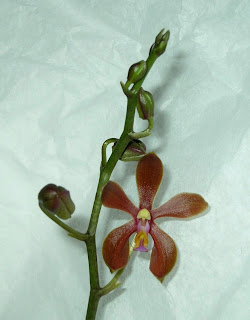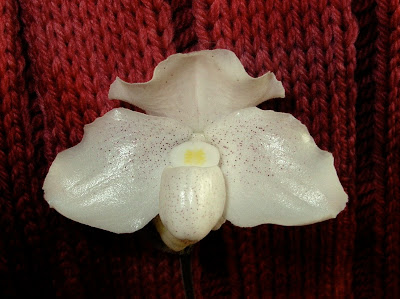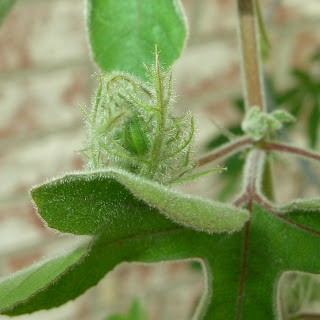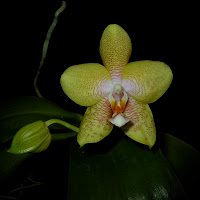Plant Sales Live on JuliaRedman.com
 People often ask me about repotting orchids. It's really very simple. What follows is a little narrative of the process. Our volunteer for the day is Paph. Wossner Goldegg, who I've shown photos of in previous posts. For reference, paphs do appreciate being repotted yearly.
People often ask me about repotting orchids. It's really very simple. What follows is a little narrative of the process. Our volunteer for the day is Paph. Wossner Goldegg, who I've shown photos of in previous posts. For reference, paphs do appreciate being repotted yearly.
Start by grooming dead leaves or inflorescences from the plant. Water the plant, since damp roots are more flexible, then give the pot a squeeze to loosen the roots, then knock or pull (gently) the plant from the pot. Hang on to the pot for the moment. Clean the old media away from the roots. If there are bits stuck to the root, don't bother to try to break them off. This just results in unnecessarily injured roots. Take this time to assess the quality of the roots. Paphiopedilums naturally have tan to brown hairy roots with yellow growing tips. They should be firm and plump. If you find any that are squishy or dried up and crispy dead, you can go ahead and gently pull them off, or at least pull off the outer covering and leave the little wiry true root in the center. Watch out for the growing tips - ideally you want to make sure they don't get damaged.
Clean the old media away from the roots. If there are bits stuck to the root, don't bother to try to break them off. This just results in unnecessarily injured roots. Take this time to assess the quality of the roots. Paphiopedilums naturally have tan to brown hairy roots with yellow growing tips. They should be firm and plump. If you find any that are squishy or dried up and crispy dead, you can go ahead and gently pull them off, or at least pull off the outer covering and leave the little wiry true root in the center. Watch out for the growing tips - ideally you want to make sure they don't get damaged.
 Now select a pot for the plant. In general, people often go with a pot that is just big enough for the roots. This prevents the occurrence of too much wetness in the pot for extended periods, which leads to root rot. Often this can mean putting the plant back into the same pot it was just in. You can see from the photos that this would work with this plant. Sometimes it can also mean going down a pot size if the roots were in trouble. Don't be afraid to do this if it will be the best thing for the plant. And of course sometimes you might find you can't easily get it back into the old pot and to put it up a size or so. In this case, even though the roots just fit in the old pot, I think they could fill a very slightly larger pot just as well, plus I tend to underwater so the plant will likely not get damage from a soggy bottom.
Now select a pot for the plant. In general, people often go with a pot that is just big enough for the roots. This prevents the occurrence of too much wetness in the pot for extended periods, which leads to root rot. Often this can mean putting the plant back into the same pot it was just in. You can see from the photos that this would work with this plant. Sometimes it can also mean going down a pot size if the roots were in trouble. Don't be afraid to do this if it will be the best thing for the plant. And of course sometimes you might find you can't easily get it back into the old pot and to put it up a size or so. In this case, even though the roots just fit in the old pot, I think they could fill a very slightly larger pot just as well, plus I tend to underwater so the plant will likely not get damage from a soggy bottom. Next of course is to fill in the pot with an appropriate media. Nature of potting media can vary considerably from person to person and plant to plant. Basically, we don't use "regular potting soil" because it stays wet too long. For paphs, most people use some pine bark or coconut husk chunk based mix (these are NOT mulch) with other additives. Also generally the bits are small, about 1/4 inch unless you're dealing with a very big plant. I prefer a coconut husk chunk (chc) mix with sponge rock, diatomite, charcoal with some organic fertilizers added. I mix my own, but if you only have a few plants you can buy mix from other growers, or sometimes get ok stuff from the hardware store.
Next of course is to fill in the pot with an appropriate media. Nature of potting media can vary considerably from person to person and plant to plant. Basically, we don't use "regular potting soil" because it stays wet too long. For paphs, most people use some pine bark or coconut husk chunk based mix (these are NOT mulch) with other additives. Also generally the bits are small, about 1/4 inch unless you're dealing with a very big plant. I prefer a coconut husk chunk (chc) mix with sponge rock, diatomite, charcoal with some organic fertilizers added. I mix my own, but if you only have a few plants you can buy mix from other growers, or sometimes get ok stuff from the hardware store.
Backfill the pot with media, gently tapping and poking it down between the roots. Tamp it enough with your fingers that it becomes reasonably solid, but not so much that you squash the roots and all the air pockets. With paphs, bring the media up to just above the bottom level of the base of the leaves, maybe 1/4 inch, so emerging roots will be protected.
 When you're done, the plant should be solid enough in the pot that you can gently pick it up by the ears and it will not come out. Be careful, this obviously will not work if there are not enough roots to anchor the plant, or if you've potted into a clay pot, or if you've used a heavy media such as for hydroponics. Incidentally, unless you're dealing with a rather large plant, I wouldn't recommend using clay pots for paphs. They dry out too fast.
When you're done, the plant should be solid enough in the pot that you can gently pick it up by the ears and it will not come out. Be careful, this obviously will not work if there are not enough roots to anchor the plant, or if you've potted into a clay pot, or if you've used a heavy media such as for hydroponics. Incidentally, unless you're dealing with a rather large plant, I wouldn't recommend using clay pots for paphs. They dry out too fast.
 We were recently visited by this most handsome fellow whom I believe to be a corn snake. I have named him "Joe". I hope he sticks around. I like snakes but have not seen many around our place.
We were recently visited by this most handsome fellow whom I believe to be a corn snake. I have named him "Joe". I hope he sticks around. I like snakes but have not seen many around our place.
 This is a first bloom seedling of Phalaenopsis (Su An Cricket x stobartiana) bred by Al. I couldn't be more tickled with it. Its miniature (well, it might get bigger as it matures, but probably not a lot), has cute-as-a-button rust colored flowers that are very shiny and somewhat fragrant. I'm very interested in breeding of the miniature species like stobartiana, and Al has had a fair amount of success with his crosses. I always enjoy browsing his young seedlings.
This is a first bloom seedling of Phalaenopsis (Su An Cricket x stobartiana) bred by Al. I couldn't be more tickled with it. Its miniature (well, it might get bigger as it matures, but probably not a lot), has cute-as-a-button rust colored flowers that are very shiny and somewhat fragrant. I'm very interested in breeding of the miniature species like stobartiana, and Al has had a fair amount of success with his crosses. I always enjoy browsing his young seedlings.
The mechanics of making crosses with miniatures have some tricks to them. For example, miniature phal species have much smaller pollen nodules than other phals, and its said that these do not have sufficient hormone to induce the necessary length in the pollen tubes. It could also be that there just not enough pollen grains to make the zillions of seed you get in one of those thumb sized phal pods. Its said that you can get around this by using the mini as the pod parent, but I'm always hesitant to do that--to paranoid to risk my minis!
A couple years ago I made a cross of P. Emily Grimball x honghenensis. Emily Grimball is a mid-sized thing with solid pink, waxy star flowers. It made a big giant pod but only a couple hundred seed. However, I figure that is enough seed for me to deal with as I do my own flasking and only have so much space. I have the first of them in compot now. I can't wait to see them bloom!
 My Ceropegia sandersoniae, a.k.a. "parachute flower", was given to me by ogecko as a rooted cutting of his plant approximately 8 months ago. Since then it has twined around several bamboo stakes in the pot and generally looked rather dopey. The vines are almost pencil thick but the leaves are about the size of a quarter or perhaps a little bigger and are not very abundant. But thats ok because now it is blooming for the first time and the flowers are really neat! From calyx to tip the flowers are an estimated 2.5 inches tall and 2 inches in diameter at the top of the parachute. The little hairs flutter slightly in the breeze, undoubtedly to help attract little bugs for pollination assistance.
My Ceropegia sandersoniae, a.k.a. "parachute flower", was given to me by ogecko as a rooted cutting of his plant approximately 8 months ago. Since then it has twined around several bamboo stakes in the pot and generally looked rather dopey. The vines are almost pencil thick but the leaves are about the size of a quarter or perhaps a little bigger and are not very abundant. But thats ok because now it is blooming for the first time and the flowers are really neat! From calyx to tip the flowers are an estimated 2.5 inches tall and 2 inches in diameter at the top of the parachute. The little hairs flutter slightly in the breeze, undoubtedly to help attract little bugs for pollination assistance.
I can't say I know much (anything) about ceropegias. I've been growing this one in an East exposure sun room, but I understand they can take more light than that. During the winter I didn't water much but have increased watering for summer. Later today I'll be dissecting a flower to see if I can determine how to pollinate them...
In the mean time, you can learn more about ceropegias here and here.
 This very elegant flower is a first bloom seedling of Paph. niveum that I purchased from Parkside Orchids this past spring at the DC Paph Forum. I have a few niveum plants and I very much enjoy them, although I like the brachypetalum species and hybrids in general. Many people claim that they have only a 2 year life span once reaching flowering size but I disagree. I suspect people over water them a little bit. Also brachys like their lime!
This very elegant flower is a first bloom seedling of Paph. niveum that I purchased from Parkside Orchids this past spring at the DC Paph Forum. I have a few niveum plants and I very much enjoy them, although I like the brachypetalum species and hybrids in general. Many people claim that they have only a 2 year life span once reaching flowering size but I disagree. I suspect people over water them a little bit. Also brachys like their lime!
Interesting, little known fact about niveum: many of them are sweetly fragrant! Not in a knock-your-socks-off way, but in a delicate, classy way, which is in agreement with their appearance. This particular one doesn't have much fragrance. It thinks about it sometime, such that I can imagine the fragrance around it, but not enough to really be of any significance. Its still a cute little guy though!
Some day if I manage to get two in bloom at once I'll pollinate one and make exciting little seeds.
 Last year I started several plants of Passiflora arida from seed given to me by my buddy ogecko, a.k.a. The Larry. Most people consider passifloras to be good growers, but this has to be one of the best. In a 2.5" cup the seedling vines got as long as 3 or 4 feet of reaching, grasping growth before being repotted into a nice big community pot with a tomato-cage gym. Even during the winter the plant continued to grow, attempting to take over my living room drapes in the process. They've been outside for a few weeks now and have responded well with a flush of new growth, production of a little anthocyanin blush, and the first buds and flowers!
Last year I started several plants of Passiflora arida from seed given to me by my buddy ogecko, a.k.a. The Larry. Most people consider passifloras to be good growers, but this has to be one of the best. In a 2.5" cup the seedling vines got as long as 3 or 4 feet of reaching, grasping growth before being repotted into a nice big community pot with a tomato-cage gym. Even during the winter the plant continued to grow, attempting to take over my living room drapes in the process. They've been outside for a few weeks now and have responded well with a flush of new growth, production of a little anthocyanin blush, and the first buds and flowers!
 Like many passifloras, arida is a delicate looking flower. Size is approximately 2.5 to 3 inches. But the filigree cage around the bud is a little more unusual. This bears some resemblance to similar structures on P. foetida, but is somewhat less branched, and has the presence of many tiny trichomes (hairs) whereas foetida appears to have larger glandular trichomes or perhaps nectaries (I've never seen one in person so I'm going on photo data). In fact, the entire plant of arida is covered with tiny hairs, except the flowers, which have a bald glory.
Like many passifloras, arida is a delicate looking flower. Size is approximately 2.5 to 3 inches. But the filigree cage around the bud is a little more unusual. This bears some resemblance to similar structures on P. foetida, but is somewhat less branched, and has the presence of many tiny trichomes (hairs) whereas foetida appears to have larger glandular trichomes or perhaps nectaries (I've never seen one in person so I'm going on photo data). In fact, the entire plant of arida is covered with tiny hairs, except the flowers, which have a bald glory.
Speaking of foetida, The Larry tells me that the two species are related. I find this believable since the arida plant as a bit of BO, and "foetida" basically means "stinky." I did not test the flowers.
Now that its flowering, perhaps I can arrange for seeds to share with everyone!
This post is a reprint from a post I put up on the EtsyPHAT blog yesterday. Thought I'd cheat a bit and reproduce it here. ;-) A study published in Feb 2008 cites keeping plants at your desk may result in more satisfaction with your job. Based on surveys, the study finds that employees with live plants or windows in their offices had more positive and mellow responses to a range of questions vs. those who lived in a basic cube. Basically, they tended to feel more like people with good jobs rather than rats in a maze with bad food.
A study published in Feb 2008 cites keeping plants at your desk may result in more satisfaction with your job. Based on surveys, the study finds that employees with live plants or windows in their offices had more positive and mellow responses to a range of questions vs. those who lived in a basic cube. Basically, they tended to feel more like people with good jobs rather than rats in a maze with bad food.
This makes me wonder if the move Office Space would have gone differently if the plant on Milton's desk wasn't dead. (check out this clip on YouTube, upper right hand corner)
Moral of the day: fix up your desk with a snazzy new plant and have a better day!
Read more about it:
The original journal article:
Dravigne, Andrea, Waliczek, Tina Marie, Lineberger, R.D., Zajicek, J.M. The Effect of Live Plants and Window Views of Green Spaces on Employee Perceptions of Job Satisfaction HortScience 2008 43: 183-187 [link]
Science Daily Report
LA Times Article
 People often ask me about repotting orchids. It's really very simple. What follows is a little narrative of the process. Our volunteer for the day is Paph. Wossner Goldegg, who I've shown photos of in previous posts. For reference, paphs do appreciate being repotted yearly.
People often ask me about repotting orchids. It's really very simple. What follows is a little narrative of the process. Our volunteer for the day is Paph. Wossner Goldegg, who I've shown photos of in previous posts. For reference, paphs do appreciate being repotted yearly. Clean the old media away from the roots. If there are bits stuck to the root, don't bother to try to break them off. This just results in unnecessarily injured roots. Take this time to assess the quality of the roots. Paphiopedilums naturally have tan to brown hairy roots with yellow growing tips. They should be firm and plump. If you find any that are squishy or dried up and crispy dead, you can go ahead and gently pull them off, or at least pull off the outer covering and leave the little wiry true root in the center. Watch out for the growing tips - ideally you want to make sure they don't get damaged.
Clean the old media away from the roots. If there are bits stuck to the root, don't bother to try to break them off. This just results in unnecessarily injured roots. Take this time to assess the quality of the roots. Paphiopedilums naturally have tan to brown hairy roots with yellow growing tips. They should be firm and plump. If you find any that are squishy or dried up and crispy dead, you can go ahead and gently pull them off, or at least pull off the outer covering and leave the little wiry true root in the center. Watch out for the growing tips - ideally you want to make sure they don't get damaged.
 Now select a pot for the plant. In general, people often go with a pot that is just big enough for the roots. This prevents the occurrence of too much wetness in the pot for extended periods, which leads to root rot. Often this can mean putting the plant back into the same pot it was just in. You can see from the photos that this would work with this plant. Sometimes it can also mean going down a pot size if the roots were in trouble. Don't be afraid to do this if it will be the best thing for the plant. And of course sometimes you might find you can't easily get it back into the old pot and to put it up a size or so. In this case, even though the roots just fit in the old pot, I think they could fill a very slightly larger pot just as well, plus I tend to underwater so the plant will likely not get damage from a soggy bottom.
Now select a pot for the plant. In general, people often go with a pot that is just big enough for the roots. This prevents the occurrence of too much wetness in the pot for extended periods, which leads to root rot. Often this can mean putting the plant back into the same pot it was just in. You can see from the photos that this would work with this plant. Sometimes it can also mean going down a pot size if the roots were in trouble. Don't be afraid to do this if it will be the best thing for the plant. And of course sometimes you might find you can't easily get it back into the old pot and to put it up a size or so. In this case, even though the roots just fit in the old pot, I think they could fill a very slightly larger pot just as well, plus I tend to underwater so the plant will likely not get damage from a soggy bottom. Next of course is to fill in the pot with an appropriate media. Nature of potting media can vary considerably from person to person and plant to plant. Basically, we don't use "regular potting soil" because it stays wet too long. For paphs, most people use some pine bark or coconut husk chunk based mix (these are NOT mulch) with other additives. Also generally the bits are small, about 1/4 inch unless you're dealing with a very big plant. I prefer a coconut husk chunk (chc) mix with sponge rock, diatomite, charcoal with some organic fertilizers added. I mix my own, but if you only have a few plants you can buy mix from other growers, or sometimes get ok stuff from the hardware store.
Next of course is to fill in the pot with an appropriate media. Nature of potting media can vary considerably from person to person and plant to plant. Basically, we don't use "regular potting soil" because it stays wet too long. For paphs, most people use some pine bark or coconut husk chunk based mix (these are NOT mulch) with other additives. Also generally the bits are small, about 1/4 inch unless you're dealing with a very big plant. I prefer a coconut husk chunk (chc) mix with sponge rock, diatomite, charcoal with some organic fertilizers added. I mix my own, but if you only have a few plants you can buy mix from other growers, or sometimes get ok stuff from the hardware store.
 When you're done, the plant should be solid enough in the pot that you can gently pick it up by the ears and it will not come out. Be careful, this obviously will not work if there are not enough roots to anchor the plant, or if you've potted into a clay pot, or if you've used a heavy media such as for hydroponics. Incidentally, unless you're dealing with a rather large plant, I wouldn't recommend using clay pots for paphs. They dry out too fast.
When you're done, the plant should be solid enough in the pot that you can gently pick it up by the ears and it will not come out. Be careful, this obviously will not work if there are not enough roots to anchor the plant, or if you've potted into a clay pot, or if you've used a heavy media such as for hydroponics. Incidentally, unless you're dealing with a rather large plant, I wouldn't recommend using clay pots for paphs. They dry out too fast.










